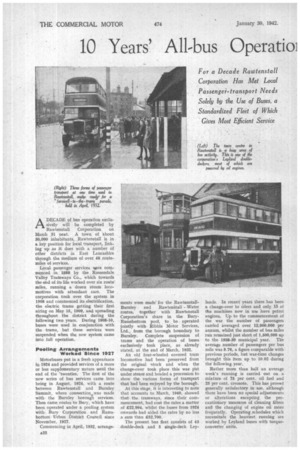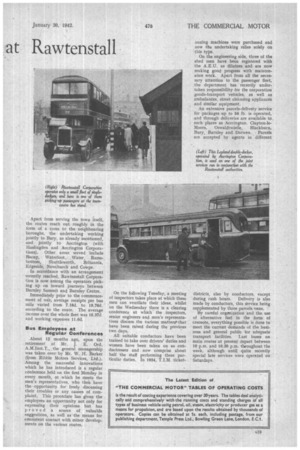10 Years' All-bus Operatia at Rawtenstall
Page 24

Page 25

If you've noticed an error in this article please click here to report it so we can fix it.
For a Decade Rawtenstall Corporation Has Met Local Passenger-transport Needs Solely by the Use of Buses, a Standardized Fleet of Which Gives Most Efficient Service
ADECADE of bus operation exclusively will be completed by Rawtenstall Corporation on March 31 next. A town of about 30.000 inhabitants, Rawtenstall is in a key position for local transport, linking up as it does with a number of other districts in East Lancashire through the medium of over 48 routemiles of services.
Local passenger services 14pre commenced in 1888 by the R,ossentiale Valley Tramways Co., which towards the end of its life worked over six route miles, running a dozen steam locomotives with attendant cars. The corporation took over the system in 1908 and commenced its electrification, the electric trains getting their first airing on May 15, 1909, and spreading throughout the district during the following two years. During 1908-10, buses were used in conjunction with the trams, but these services were suspended when the new system came into full operation.
Pooling Arrangements Worked Since 1927 Motorbuses put in a fresh appearance in 1924 and provided services of a more or less supplementary nature until the end of the 'twenties. The first of the new series of bus services came into being in August, 1924, with a route between Rawtenstall and Burnley Summit, where connection, was made with the Bornley borough services. Then came routes to Bury, which have been operated under a pooling system with Bury Corporation and Ramsbottom Urban District Council since November, 1927.
Commencing in April, 1932, arrange ments were made for the RawtenstallBurnley and Rawtenstall Water routes, together with Rawtenstall Corporation's share in the BuryRamsbottom pool, to be operated jointly with Ribble Motor Services, Ltd., from the borough boundary to Burnley. Complete suspension of trams and the operation of buses exclusively took place, as already stated, at the end of March, 1932.
An old four-wheeled covered tram locomotive had been preserved from the original 'stock and when the change-over took place this was p'ut under steam and headed a procession to show the various forms of transport that had been enjoyed by the borough.
At this stage, it is interesting to note that accounts to March, 1940, showed that the tramways, since their commencement, had cost the rates a matter of £22,994, whilst the buses from 1924 onwards had aided the rates by no less a sum than 252,700.
The present bus fleet consists of 43 double-deck and 5 single-deck Ley
lands. In recent years there has been a change-over to oilers and only 15 of the machines now in use have petrol engines. Up to the commencement of the war the number of passengers carried averaged over 12,000,000 per annum, whilst the number of bus miles run remained just short of 1,500,000 up to the 1938-39 municipal year. The average number of passengers per bus mile was 8.76, a figure comparable with previous periods, but war-time changes brought this item up to 10.02 during the following.year.
Rather more than half an average week's running is carried out on a mixture of 75 per cent, oil fuel and 25 per cent. creosote. This has proved generally satisfactory in use, although there have been no special adjustments or alterations excepting the precautionary measures of cleaning filters and the changing of engine oil more frequently. Operating schedules which necessitate the heaviest running are worked by Leyland buses with torqueconverter units.
Apart from serving the town itself, the routes reach out roughly in the form of a cross to the neighbouring boroughs, the undertaking working jointly to Bury, as already mentioned, and jointly to Accrington (with Haslingden and Accrington Corporations). Other areas served include Bacup, Waterfoot, Water, Ramsbottom, Shuttleworth, Britannia, Edgesidc, Newchurch and Cowpe.
In accordance with an arrangement recently reached, Rawtenstall Corporation is now among the operators picking up on inward journeys between Burnley Summit and Burnley Centre.
Immediately prior to the commencement of war, average receipts per bus mile varied from 7.18d. to 19.76d. according to the route. The average income over the whole fleet was 16.37d and working expenses 11.0d.
Bus Employees at Regular Conferences About 12 months ago, upon the retirement of Mr. J. E. Ord, A.M.Inst.T., the general managership was taken over by Mr. W. H. Barker (from Ribble Motors Services, Ltd.). Among the successful Innovations which he has introduced is a regular conference held on the first Monday in every month, at which he meets the men's representatives, who then have the opportunity for freely discussing their troubles or any causes of complaint. This procedure has given the employees an opportunity not only for expressing their opinions but has proved a source of valuable suggestions, as well as the means for consistent contact with minor developments on the various routes. On the following Tuesday, a meeting of inspectors takes place at which these men can ventilate their ideas, whilst on the Wednesday there is a clearing conference at which the inspectors, senior engineers and men's representatives discuss the various matters' that have been raised during the previous two days.
All suitable conductors have been trained to take over drivers' duties and women have been taken on as conductresses and now comprise about half the staff performing these particular duties. In 1934, T.I.M. ticket
issuing machines were purchased and now the undertaking relies solely on this type.
On the engineering side, three of the shed men have been registered with the A.E.U. as dilutees and are now making good progress with maintenance work. Apart from all the necessary attention to the passenger fleet, the department has recently under. taken responsibility for the corporation goods-transport vehicles, as well as ambulances, street cleansing appliances and similar equipment.
An extensive parcels-delivery service for packages up to 56 lb. is operated, and through deliveries arc available to. such places as Accrington, Clayton-leMoors, Oswaldtwistle, Blackburn, Bury, Burnley and Darwen. Parcels are accepted by agents in different districts, also by conductors, except during rush hours. Delivery is also made by conductors, this service being supplemented by three parcels vans.
By careful organization and the use of alternative fuel in the form of creosote, everything possible is done to meet the current demands of the business and general public for adequate transport facilities. Last buses on main routes at present depart between 10 p.m. and 10.30 p.m. throughout the week, although until quite recently special late services were operated on Saturdays.




















































